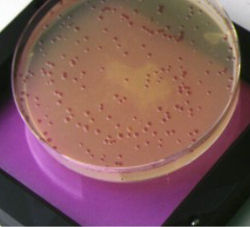Slowing Light with Biology

Atomic vapors and solids like ruby have slowed light to a snail’s pace. Now a biological material can do the same trick. In the 16 December PRL researchers report that a film of protein derived from bacteria slows light to less than 0.091 millimeters per second, the slowest yet, short of the “stopped light” demonstrated a few years ago. The team also precisely controlled the light’s speed using a second light beam. They suggest that similar biological materials could route signals in optical computers and telecommunications networks.
Light shoots through empty space at 300 million meters per second, but interaction with molecules slows it down. To learn more about the limits of light propagation through matter, researchers have recently slowed light dramatically and even briefly stopped it. The first experiments used ultracold atomic vapors and high-end lasers, but in 2003 researchers came up with a simpler technique, called coherent population oscillation (CPO), that works at room temperature with more ordinary lasers [1].
In CPO, laser light hits a material whose molecules can be excited by the laser photons to a very long-lived quantum state. Researchers vary the laser intensity as a slow sine wave. The period of the wave roughly matches the lifetime of the state. In each cycle, as the wave’s intensity increases toward its peak, photons are absorbed by the material until all of the molecules have been promoted to the long-lived, excited state. In this temporarily “saturated” condition, the material allows more of the following photons to pass through. When the excited molecules drop back down to the ground state, they emit photons and begin the cycle again. Since photons are absorbed from one part of the cycle and added to a slightly later part, the net result is that the sine-wave input signal shifts backward in time–that is, the light signal slows.
Bacteriorhodopsin (bR) is a bacterial protein whose excited state lifetime is almost a full second, so Pengfei Wu of New Span Optotechnology in Boston and Devulapalli Rao of the University of Massachusetts, also in Boston, thought it would be ideal for the CPO technique. The long-lived state occurs when, after absorbing a photon, the large molecule twists its three-dimensional structure into a strained, high-energy conformation.
Wu and Rao mixed bR molecules into a polymer film about 100 microns thick and sent green laser light into the film. They varied the light intensity at frequencies as low as 0.1 hertz and found that the output sine wave was delayed by as much as a second, corresponding to their record low light speed.
The researchers found they could alter the delay by shining a blue laser at the film. The blue photons forced the bR molecules to relax back to their original shape faster and emit the green photons sooner. By changing the intensity of the blue light, they could fine-tune the speed of the green sine wave from its slowest crawl all the way up to normal light speed. Controlling the speed of one light signal with another over such a wide range is unprecedented, and the technique could be useful in all-optical circuits of the future, where precise control over the speed of each signal will be essential. But bR is not ideal for devices because it responds extremely slowly to controlling signals, such as the blue light.
“They have found a new physical mechanism for controlling the speed of light,” says Robert Boyd of the University of Rochester in New York, who pioneered the CPO slow light technique. “This is a very splashy result,” but he cautions that the slow response time might make it impractical for all but a few applications such as real-time holography. Other biological materials that work on the same principle as bR but with faster response times might be more suited to high-speed devices, according to Wu and Rao.
–Kim Krieger
Kim Krieger is a freelance science writer in Norwalk, Connecticut.
References
- M. S. Bigelow, N. N. Lepeshkin, and R. W. Boyd, “Observation of Ultraslow Light Propagation in a Ruby Crystal at Room Temperature,” Phys. Rev. Lett. 90, 113903 (2003)
More Information
uses for bR in technology, such as ID cards, from Univ. of Marburg (Click on “Research,” then on the word “Bacteriorhodopsin,” then on “Pictures.”)
a critique of the CPO technique (from ArXiv, not peer-reviewed)Focus story on slow light from 1999


